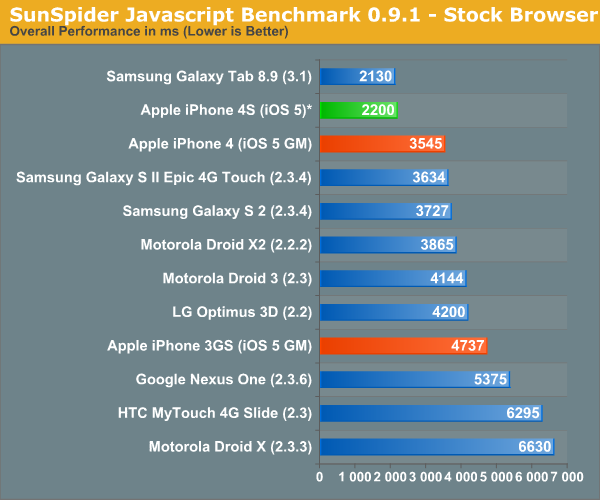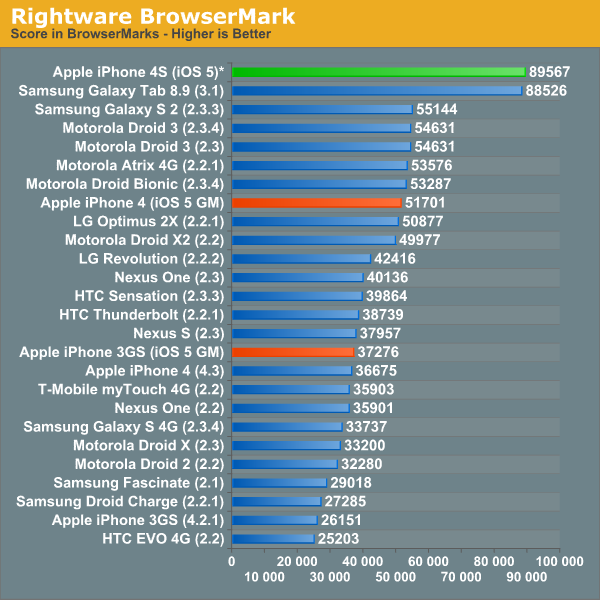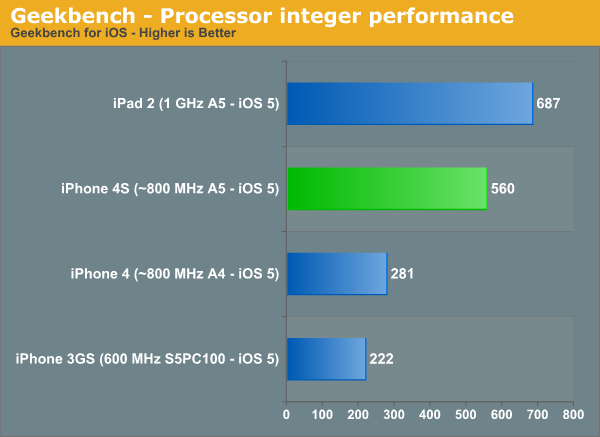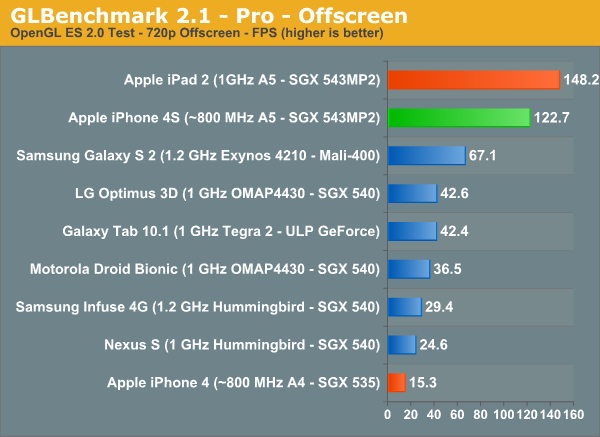iPhone 4S Preliminary Benchmarks: ~800MHz A5, Slightly Slower GPU than iPad 2, Still Very Fast
by Anand Lal Shimpi & Brian Klug on October 11, 2011 3:22 AM EST- Posted in
- Smartphones
- Apple
- Mobile
- iPhone 4S
- SoCs
Apple's ability to control the entire information chain, down to the point of limiting leaks, appears to be gradually slipping as it grows as a company. Case in point are the numerous hardware and performance leaks surrounding the newly launched iPhone 4S. Little did we know that several weeks ago we were staring at photos of the 4S' PCB, and more recently we've seen the first performance results from Apple's first A5 based smartphone thanks to a few eager users around the web. We've compiled these results here from various sources (all linked below) and compared them to our existing database of tests.
The results are pretty much as expected. Javascript performance finally catches up to Tegra 2 based Honeycomb devices, while general CPU performance is significantly higher than the iPhone 4. I suspect Ice Cream Sandwich will bridge the Android smartphone gap (the Honeycomb equipped Gtab 8.9 is here to give you an idea of where a more modern Android browser ends up).
Keep in mind that all of these tests measure performance of the software stack in addition to the hardware. In particular the web browser tests depend largely on browser optimizations, which is why we see differences between similar hardware running different browser versions. Also note that all results were run at stock, with the stock browser. Finally, although these browser tests were captured on video we'll still be running our official tests once our 4Ses arrive and will update accordingly.


Using some of the integer and fp tests of published Geekbench scores we can already conclude that Apple is shipping a lower clocked A5 in the iPhone 4S than it does in the iPad 2. This naturally makes sense as the iPhone 4S has a much smaller 5.25 Whr battery. Based on the Geekbench results it looks like the iPad 2 is clocked around 25% higher than the iPhone 4S, pegging the latter's clock speed at 800MHz.


A lower clock not only means higher yields from the factory, but likely a lower operating voltage as well. Dropping a CPU's core voltage, yields a greater-than-linear decrease in power consumption, making the marginal loss in clock speed a good choice. At a lower operating frequency than its Android competitors, Apple does have to exploit its strengths in software to avoid any tangible performance penalties. Apple has traditionally done this very well in the past, so I don't expect the loss of frequency to be a huge deal to the few who do cross-shop iOS and Android.
Unsurprisingly, memory bandwidth doesn't appear to have gone up either compared to the iPad 2's A5 (taking into account scaling due to CPU clock increases). The Samsung part number on the iPad 2's A5 indicates two LPDDR2-800 die on package, it's safe to assume that whatever Apple clocked the memory interface at in the iPad 2 remains unchanged in the iPhone 4S.
The GPU results tell a similar story courtesy of some early GLBenchmark 2.1 results. The 960 x 640 results are useless as they are bound by vsync at ~60 fps. Luckly GLBenchmark 2.1 added an off-screen render mode at 1280 x 720 where we can really see the differences between the iPad 2 and iPhone 4S A5 implementations:


Here the iPad 2 holds a ~21% performance advantage, which once again I assume to be all related to clock speed. Also note the huge advantage over the existing iPhone 4. The GPU power in the 4S should be more than enough to run any well written, current generation title at well north of 30 fps on its display.
We'll be reviewing the iPhone 4S in the coming weeks, stay tuned!
Source: GLBenchmark Database, Geekbench Database, Macrumors










216 Comments
View All Comments
kgunn - Wednesday, October 12, 2011 - link
>>While I would bet the homogeny of software and hardware in Apple closed environment does lend effciency to their designprecisely...closed system luxury.
damn all the industry standard sw interfaces...just hardcode/backdoor the sw for maximum performance.
KoolAidMan1 - Wednesday, October 12, 2011 - link
It's the latter. WP7 and iOS devices on 2010 hardware are much smoother than even the latest Android handsets. The Android OS is a huge obstacle to performance until they fix hardware acceleration of the UI, etc etc.AnandReader1999 - Wednesday, October 12, 2011 - link
Its a combination of things. Apple controls the Whole process, from beginning to end. They make the hardware, they make the software and they decide what you get for both and what performance you will see for the price they want to charge.The iPhone 4S is ONLY powerful due to its GPU. It is the most advanced on the market. The second is the Samsung Mali 400 (in its first version). If Apple didn't have massive market pressure on it from Samsung/Android, it would have run with only a slightly updated GPU. Want proof...look at the performance the GPU on the 3GS & 4 compared to the 4S.
And to other's above...older designs are not bad...it just depends on what your technical goals are and the costs you want to pay.
On the topic of 'needing' newer hardware to compete. Not really. Anands' preview stuff used only the phone's stock software. None of the actual advantages Android user's have was taken into account. Using a faster tabbed browser is a given. Taking into account Android can see native Flash, iPhone can not. How about the fact that in the Dolphin browser I can set it to whatever display method I want (i.e. Desktop, iPhone, Mobile, Native Android, etc.) by the flip of a switch AND because I can see flash, I can see the entire site on my whole 4.3" of screen......
I think if we actually compared strengths between the phones, they would be very much the same (iPhone to SG2 for example). The only difference would be that in 'some' cases, the 4S GPU wins out, but since no games take advantage of that, its a moot point. All screens are locked to 60fps, so extra horsepower gets wasted or (in the future) allocated to more background processing, which the current games aren't using.
doobydoo - Sunday, October 16, 2011 - link
The mali 400 in the SG2 is not just '2nd best' to the Power 543 in the iPhone 4S. It's less than half as fast. That's a major, major difference.You can use apps to allow flash if you want. iPhone users can also 'see the entire site' on their screen.
The bottom line is the iPhone 4s is faster, more responsive in everything (even when taking pictures, for example), has a larger app library, better battery life, smaller physically (volume), and has far far fewer user complaints than the Samsung.
doobydoo - Sunday, October 16, 2011 - link
Yeah a lot of people mistake clock speed for performance.The 800mhz iPhone 4S beats any Android CPU/GPU performance on the market today
Omid.M - Tuesday, October 11, 2011 - link
I would put it at 6-8 months. That is, the AT&T SGS2 could take about 6-8 months AFTER ICS debuts to receive that version OS via OTA. At least, I think that's par for the course for most carriers/manufacturers.Brian? Anand? Thoughts?
This is what will always hurt Android: time to OS updates due to fragmentation (skinning, diff carrier bloatware).
I'm personally waiting to see Nexus "Prime" vs HTC Vigor...and would prefer Prime only for the speedy updates and longevity of the device in terms of support. Otherwise, I think the best and most impressive devices will be using Krait, which is likely Q3 2012 at the earliest (sadly).
At that point, I'd be comparing the best Krait Android device vs (hopefully) an iPhone "5"...
@moids
JasonInofuentes - Tuesday, October 11, 2011 - link
Agree @moids. There's always hope in the custom ROM world to get updates, often more reliable than the updates pushed by carriers, but not everyone is comfortable with that sort of thing. And another +1 to you for your Krait supposition. That is going to be a potent chipset and will offer a power bargain integrating so many radios and processing power into a light package. But that won't stop me from upgrading this Fall. OG Droid has seen its end.Jason
Omid.M - Tuesday, October 11, 2011 - link
I saw you go Office Space on the OGD. Have Brian record it with you, stomping on the chassis with your Vibrams.I get 15% cut if this goes viral =)
Omid.M - Tuesday, October 11, 2011 - link
*say@moids
3DoubleD - Tuesday, October 11, 2011 - link
My Droid (Milestone actually) has is also nearing it's last days in my pocket. The Bionic review really has me worried for the Prime though. Battery life is just pathetic. Hopefully I can just disable LTE for data altogether. 3G was fast enough on my Droid, I don't think I'll be missing out much. That will be the stopgap solution until Krait...I too hope for the Nexus Prime to be excellent as I would love to get speedy updates from Google. I currently enjoy the custom ROM scene on my droid, running stock 2.3.6 right now, but stability has always been an issue (I entirely blame Motorola for being )